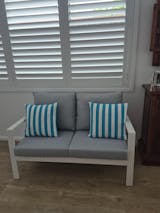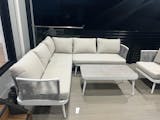As the weather cools and the desire for a warm, cosy home grows, many Australians turn to electric fireplaces for both their aesthetic appeal and practicality. Freestanding electric fireplaces have become a popular choice due to their ease of installation, portability, and lower maintenance compared to traditional wood-burning or gas fireplaces. However, an important consideration is their energy efficiency. Understanding how these fireplaces consume energy and how to use them effectively can lead to significant savings on heating costs.
Understanding Energy Consumption
Freestanding electric fireplaces operate by converting electrical energy into heat, using either a fan-forced heater or infrared technology. The efficiency of these devices is often measured by their wattage and the amount of heat they produce. Most electric fireplaces typically use between 1,000 and 1,500 watts, which can generate around 5,100 BTUs (British Thermal Units) of heat per hour. This is sufficient to heat a room of approximately 37 square metres.
When compared to traditional heating methods, electric fireplaces are generally more efficient because they convert almost all the electrical energy into heat without losing energy through a chimney or flue. Additionally, because they can be used to heat specific rooms, they offer the potential for zone heating, reducing the need to heat the entire house.
Tips for Maximising Efficiency
To ensure you get the most out of your freestanding electric fireplace, consider the following tips:
1. Use Zone Heating
One of the key advantages of freestanding electric fireplaces is their ability to provide zone heating. Instead of heating the entire house, you can use the fireplace to warm up the room you’re currently in. This reduces the overall energy consumption and focuses the heat where it’s needed most. Close doors to unused rooms to prevent heat from escaping and maximise the efficiency of your fireplace.
2. Adjust Thermostat Settings
Many electric fireplaces come with built-in thermostats that allow you to set the desired temperature. Adjusting the thermostat to a lower but comfortable setting can significantly reduce energy consumption. For every degree you lower the thermostat, you can save about 5% on your heating bill. Use a separate room thermometer to monitor the actual temperature, as the built-in thermostats can sometimes be slightly inaccurate.
3. Utilise Timer and Remote Features
Modern freestanding electric fireplaces often include timers and remote controls. These features can be incredibly useful for managing energy use. Set the timer to turn the fireplace off after you’ve fallen asleep or when you leave the room. This ensures that the fireplace isn’t running unnecessarily, thus saving energy. The remote control can also be handy for adjusting settings without getting up, encouraging more frequent adjustments to optimise energy use.
Choosing the Right Fireplace
Selecting the right freestanding electric fireplace for your needs is crucial for energy efficiency. Consider the following factors:
1. Size and Wattage
Ensure the fireplace is appropriately sized for the room you intend to heat. A unit that is too small won’t heat the space effectively, causing it to run longer and use more energy. Conversely, an oversized unit will consume more power than necessary. Measure the room’s dimensions and consult the manufacturer’s guidelines to find a fireplace with the appropriate wattage for your space.
2. Energy-Efficient Models
Look for models that are specifically designed to be energy efficient. These may include features like adjustable heat settings, programmable timers, and energy-saving modes. Some models also use LED technology for the flame effect, which consumes less power than traditional bulbs.
Additional Energy-Saving Tips
Beyond the direct use of the fireplace, there are other strategies to enhance your home’s overall energy efficiency:
1. Insulate Your Home
Proper insulation is key to maintaining a warm home. Ensure that your walls, ceilings, and floors are well insulated to prevent heat loss. Check for drafts around windows and doors and seal any gaps to keep the warm air inside.
2. Use Curtains and Blinds
During the day, open curtains and blinds to let in natural sunlight, which can naturally warm your home. Close them at night to add an extra layer of insulation and prevent heat from escaping.
3. Regular Maintenance
Keep your electric fireplace in good working order by performing regular maintenance. Clean the filters and check for any signs of wear and tear. A well-maintained fireplace operates more efficiently and lasts longer, saving you money in the long run.
Freestanding electric fireplaces offer a convenient and stylish way to heat your home, especially when used efficiently. By understanding their energy consumption and implementing strategies such as zone heating, adjusting thermostat settings, and choosing the right model, you can enjoy the warmth and ambiance of an electric fireplace while keeping your energy bills in check. Combine these efforts with overall home energy-saving practices to create a cosy, cost-effective living space.
Moda Living is celebrating 11 amazing years! To thank you for your support, enjoy an extra 10% OFF storewide. Use code MODA11YEARS at checkout and elevate your space today. Shop now at modaliving.com.au! #ModaLivingAnniversary #HomeDecor
Read More
Celebrate Moda Living's 11th Anniversary with Extra Savings!
Condo Living: Advantages of Freestanding Electric Fireplaces
Modernizing Your Office Space with a Wall-Mounted Electric Fireplace
Exploring the Latest Decor Trends in Melbourne: A Blend of Style and Sustainability
Distinctive Decor: Unveiling Brisbane's Unique Home Style Trends
How to Design an Eye-Catching Focal Point in Your Living Room
Choosing Your Flame: Electric vs Wood Fireplaces Compared
Choosing the Perfect Electric Fireplace: A Comprehensive Guide















